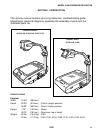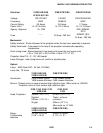
9/92
1-3
MODEL 2100 OVERHEAD PROJECTOR
PRINCIPLES OF OPERATION
Optics (See Figure 1-2)
The light source for the Overhead Projector
is 275 watt, 24 volt, Tungsten Lamp listed
as ANSI Code FNT and rated at 75 hours.
An external reflector is needed with this
lamp.
Care should be exercised to prevent
excessive vibration or jarring of the
projector when the lamp is on. The lamp
filament becomes more brittle at the
operating temperature of the projector and
shocks may cause premature failure of the
lamp.
The glass envelope should not be touched
by the fingers when inserting the lamp in
the lampholder. Oils on the skin may
combine with the glass to form blisters
which also will shorten the life of the lamp.
The Fresnel lens, located above the lamp
and directly beneath the projection stage, is
a condensing lens which consists of a
series of concentric rings, each of which
has a surface curvature similar to that of a
thick smooth lens. The Fresnel lens is made
of plastic and may be severely damaged if
the fan is stopped or the paths of cooling air
blocked. Proper alignment and direction of
the Fresnel lens is essential in order to
maintain the resolution and brightness
specifications for the projector.
The stage glass provides a convenient flat
surface for placing transparencies and other
materials to be projected. Because the light
passes through the stage, these projection
materials must be transparent.
There are two (2) different projection head
assemblies available for the projector. One
is an Open Triplet Head with focus
correction which has a triplet lens and front
surface mirror and the second a closed
Doublet Head which has one or two
condensing lens(es) and a front surface
mirror. The projection head is located
directly over the center of the Fresnel Lens.
The projector is focused by raising or
lowering the projection head.
Proper alignment of the optical components
and a clean machine are essential if the
maximum operating capabilities of the
overhead projector are to be realized.
Cleaning and alignment procedures are
discussed in Sections 2 and 4 inclusive.
Cooling (See Figure 1-3)
Cooling of the overhead projector is
accomplished by a motor-driven fan located
next to the lamp housing. The cooling air
enters the projector through opening “A”
and exits through opening “B.” (See Figure
1-3) It’s important that the flow of cooling air
not be restricted either by placing projector
too close to a wall (about one foot
clearance is necessary) or by leaving
foreign objects inside the projector.


















